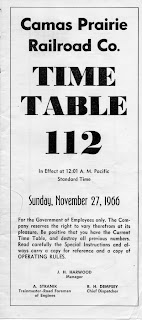One of my other passions, besides family and railroading, is ice hockey. More to the point, Chicago Blackhawks ice hockey! Being born and raised in the Chicago area, I am naturally a fan of all Chicago sports teams, but the Blackhawks are, without a doubt, my favorite of them all. I have been a Blackhawks fan since 1982 when I went to my first game at the old Chicago Stadium. The years from 1996 to 2007 though, were about as tough on a die hard fan as possible. The 'Hawks were really brutal during those years!
Since the 'Hawks re-birth during the 2007-2008 season, I have really gotten back into hockey. After winning the Stanley Cup last season, something I never thought I would see in my lifetime, I have been just giddy! But that was last season, and this season has been, well, extremely difficult.
The defending
Stanley Cup Champion Chicago Blackhawks ( I will NEVER get tired of saying that) had to jettison a large part of their team due to the NHL's ridiculous salary cap rules, including their winning goal tender, so a large part of this season required a lot of "getting to know your team mates" time and the 'Hawks have been on the playoff bubble for most of the season.
Back in October, a couple of my good model railroad friends, John Bauer and Dave Lehlbach, and my dad, went to a game in the United Center versus the Vancouver Canucks, the game was a tie with the 'Hawks winning in the shootout. One of the things we discussed during that game was the home and home series the 'Hawks would play against the hated Detroit Red Wings at the end of the season and how it would affect the standings. My thoughts at the time were the Hawks would be playing for the division at the end of the season. Well...
Instead they played for their playoff lives. This morning when I woke up, they were in "the you win, you're in" situation. A loss would mean the Dallas Stars would have lose also, a prospect that seemed unlikely, since they would be playing a team out of the playoffs with nothing to really play for. After a hard fought game, the 'Hawks were defeated by Detroit 4-3. I felt sick. Only two teams in recent history have won the Stanley Cup and then missed the chance to defend their title the following year. Not only did I want watch the 'Hawks in the playoffs again, but I didn't want them to be in such dubious company!
The Dallas Stars, who were now in the "win and in" situation and I figured it was no-brainer. But it's tough to win in the NHL and the Stars played a Minnesota Wild team who decided to show up and give them a game. In the end, the Stars succumbed to the pressure and lost 5-3. So the 'Hawks are in the playoffs to defend their title!
I should have been working on my layout today, and after the 'Hawks lost, I figured I would just ignore Stars game, but I couldn't get away from watching it. Kinda like watching a car crash or something. Late in the game I was rooting so hard for the Wild one my greyhounds came over to me and started sniffing and licking me to make sure I was OK.
It's now 11PM and I'm just now calming down. Considering the emotional highs and lows and how amped up I got today, there is no way I should have been handling any power tools! So "
here come the Hawks, the mighty Blackhawks"...into Vancouver, BC, with a date with the best in the NHL Canucks. It may be a short series, but its the playoffs baby...Cue the
Chelsea Dagger!!!
What a day!














